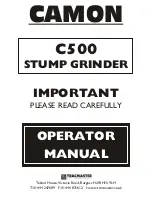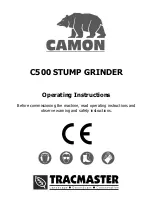
16
17
www.raider.bg
necessary or can be controlled well enough.
6.6. Grinding discs, flanges exposed discs or other tools must be applied precisely to fit your shaft grinding
machine. Working tools that do not fit exactly to the grinding spindle, rotate unevenly vibrate heavily and can
lead to loss of control over the machine.
6.7. Do not use damaged work tools. Before each use inspect the working tools, for example abrasive discs for
cracks or dislodge undergoing discs for cracks or wear strong, wire brushes poorly secured or broken staples. If
you miss grinding tool or work, check them carefully for damage or use undamaged new work tools. Once you
have checked carefully and work tools are installed, allow grinding to work at maximum speed for one minute.
Stay and keep nearby people away from the plane of rotation. The most commonly damaged work tools break
during this test period.
6.8. Work with personal protective equipment. Depending on the application work with all face mask, eye
protection or goggles. If necessary, work with breathing mask, silencers (hearing protectors), work shoes or
special apron that protects you from work to dislodge small particles. Your eyes must be protected from flying
into the working area of particles. Dust mask or a breathing filter dust arising from work. If you are exposed for
long periods of loud noise, this can lead to hearing loss.
6.9. Beware others to be a safe distance from work area. Anyone who is in the work area must wear personal
protective equipment. Break off pieces of the work piece or work tool may result in a strong acceleration to fly
away and cause damage well beyond the working area.
6.10. If you perform activities which threaten to fall working tool of hidden wires under tension or affect the
power cord, hold power only isolated handles. When entering the working tool in contact with the wires under
tension, it is transmitted through the grinding metal parts, and this may lead to electric shock.
6.11. Keep the power cords a safe distance from rotating work tools. If you lose control of the grinding, the cable
can be cut or fascinated by the working tool and it can cause injuries
6.12. Never leave grinders before working tools to completely stop its rotation. Rotary tool can touch the object,
resulting in losing control of the grinding machine.
6.13. While transport your angle grinder, do not let on. Accidental touch your clothing or hair can be swept from
the working tool, with the result that the working tool may be hurt your body.
6.14. Regularly clean the vent on your angle grinder. Turbine motor of dust sucked into the body, and the
accumulation of metal powder increases the risk of electric shock.
6.15. Do not use grinders near flammable materials. Flying sparks can cause the ignition of such materials.
6.16. Do not use the work tools that require the application of coolant. Use of water or other coolant can cause
electric shock.
7. Recoil and tips for avoiding it.
7.1. Kickback is the sudden reaction of the machine following a wedge or blocks the rotating working tool, for
example abrasive disc, rubber subjected disk wire brush and others. Wedge or block leads to sharp braking of
the rotation of the working tool grinders consequently receives strong acceleration in the direction opposite
to the direction of rotation of the tool at the point of blocking, and became unmanageable. If for example
block abrasive disk or block in the processing device, the edge of the disc, which touches the work piece may
be the disc to bend and break or recoil occurs. In this case, the disk is accelerated to working with machinery
or in the opposite direction, depending on the direction of rotation of the disc and place of the wedge. In such
cases, abrasive discs and can break. Recoil occurs as a result of improper or incorrect use of angle grinders. Its
occurrence can be prevented with appropriate protective measures described below.
7.2. Keep grinding hard and keep hands and body in such a position that can withstand the eventuality of a
kick. If a grinding auxiliary handle, always use it to control it better in recoil or the emergence of reactionary
moments in time of inclusion. If the pre-take the proper precautions in the event of recoil or strong reaction
times can master the machine.
7.3. Never put your hands near the rotary working tools. If the kick occurs, the instrument can make you hurt.
7.4. Avoid stand in the area where it would bounce angle grinder in the event of kickback. Kick the machine
moves in a direction opposite to the direction of movement of the working tool in the area of blockage.
7.5. Work with great caution in the areas of corners, sharp edges and others. Avoid repulsion or wedge of working
tools in the work piece. When handling sharp corners or sharp edges or repel the rotating working tool there is
increased danger of wedge. This causes a loss of control of machinery or recoil.
7.6. Do not use a chain or toothed cutting sheets. Such work tools often cause recoil or loss of control over
grinding.
8. Specific instructions for the safe operation of grinding or cutting with abrasive disks
8.1. Use only provided for your abrasive grinding discs and used for abrasive disc guard. Abrasive disks are not
designed for grinding may not be well shielded and do not guarantee safe operation.
8.2. Guard must be securely attached to grinders and be located so as to ensure maximum safety, for example
abrasive disk should not be covered by a mantle directed to working with the machine. Housing should prevent
the machine from working with scatter to dislodge pieces from coming into contact with the rotating abrasive
disk.
8.3. The use of abrasive discs only for the purposes for which they are provided. For example: never grind with
the side of a disc cutting. Cutting discs are designed for removing material with its edge. Lateral application of
force can break them.
8.4. Always use a retainer nut (8), which are in impeccable condition and correspond in size and shape of the
used abrasive disk. Locking nuts (8) for the blades may differ from those discs for grinding. In some models,
locking nuts (8) can be used for and drives for grinding, having screwed on the reverse side with the projecting
part of the disc.
8.5. Do not use abrasive discs worn by larger grinders. Discs for older machines are not designed for high-speed
rotation, which rotate in small and can break.
9. Specific instructions for safe handling of blades.
9.1. Avoid blocking the cutting disk or pinched him strong. Not perform very deep cuts. Overloading of the
cutting disc increases the risk of wedge or blocks it, and thus the occurrence of recoil or fracture while spinning.
9.2. Avoid the area will be in front of and behind the rotating cutting disc. When cutting disc is in a plane with
your body in case of recoil angle grinder with the rotating disk can bounce directly to you and hurt you.
9.3. If the cutting disk when block or interrupting work grinding off and leave it until after the final stop of the
rotation of the disc. Never attempt to remove the turntable from the cutting channel, otherwise the recoil may
occur. Identify and remove the cause of the wedge.
9.4. Do not switch the angle grinder again if the disc is cut in detail. Be carefully before you continue cutting,
cutting disc to wait up to full speed. Otherwise, the disc cans block to rebound from the work piece or cause
recoil.
9.5. Provide a stable attachment of large parts in an appropriate way to limit the risk of recoil jammed as a result
of cutting disc. During cutting large parts can be bent into action under its own weight.
9.6. Be especially cautious in cutting channels in walls or other areas that can conceal surprises. Cutting disc can
cause the machine to kick to touch or gas pipelines, power lines or other objects.
10. Specific instructions for safe operation in grinding with sandpaper.










































